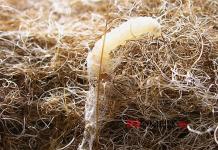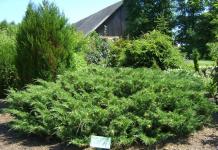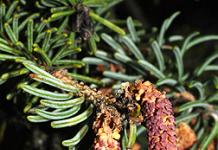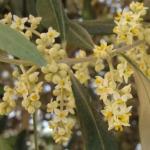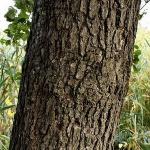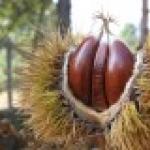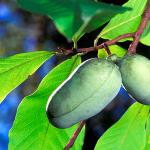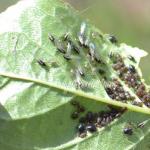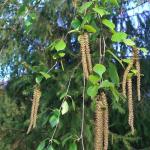Each year, edible chestnut seedlings are sold at seedling size in the spring or closer to summer. Many people would like to plant a chestnut tree in their dacha or country plot and admire it for many years.
Meet the edible chestnut.
The chestnut is a tall, beautiful tree, but few people know that the edible chestnut blooms differently than the inedible one and is shorter in height. The flowers of the edible chestnut look more like nut flowers, such pod-like inflorescences. Many people like the taste of edible chestnuts raw rather than roasted. Sometimes they are confused with horse chestnuts, but horse chestnuts are incredibly bitter in taste, you won’t eat them, they are considered poisonous.
Various dishes are prepared from edibles, as well as from nuts: soufflés and desserts, and they are used to stuff confectionery products. The fruits have a lot of fiber and little fat, and a lot of minerals and tannins.
If during the winter the chestnut fruits have dried out, become excessively dry, then it is useless to germinate them; nothing will grow. Normal seed storage in winter is achieved through a process called stratification. This is placing the fruits in damp sand and in the refrigerator for a long time.
In the Moscow region, with proper care, you can grow edible fruits of different varieties. The tree will need additional protection in winter, well-drained, rich soil and a specific level of moisture.
The most common types of edible chestnuts grown in Russia:
Japanese chestnut;
Chinese chestnut is the softest;
European chestnut.
Japanese chestnut
The name of this species comes from the country - its homeland, in which it is found even in the wild. In its homeland, Japan, the species is called Kuri; more than 100 varieties of this species have been bred. It is worth noting that the fruits of Japanese chestnut are consumed only when grown on cultivated trees. The species of wild Japanese chestnut is also found in China, North America, Korea, and it also grows on the Black Sea coast. Chestnut is quite picky about climate; successful cultivation of the plant requires a moderate, humid climate. The plant does not tolerate prolonged frosts with temperatures below -200C. One of the advantages of growing this plant is that it is not susceptible to various fungal diseases and begins to bear fruit 4 years after planting. Fruit composition: Japanese chestnut fruits contain about 62% starch and sugar, approximately 7% fat.



Chinese chestnut is the softest
A species called “Softest Chinese chestnut” grows in nature in China, as well as in nearby countries - Korea, Vietnam. In addition to the listed countries, the plant has taken root well in North America and is also grown in Western Europe. An interesting fact is that after this variety of chestnut was planted in North America, the species called “toothed chestnut” gradually disappeared. Plants of this species died from the fungus Endotica Parasitica introduced by the Chinese chestnut, and the fungus does not harm the Chinese chestnut, since the plants have developed immunity.
It is worth noting that this species grows well in soils enriched with calcium. An interesting feature of the plant is its large growth - on average 20 meters. Chestnut fruits weigh about 30 grams; when unripe, they are white; as they ripen, the fruits darken and turn brown.
The fruits of the Chinese chestnut are highly valued in cooking, they are soft, and various soufflés and desserts are made from them. The mild taste and delicate aroma evoke many associations with roasted chestnuts, which are sold by merchants on the streets of Paris. The unique spirit of the roast dish, which cannot be confused with anything else, remains a favorite for many for many years. Some people like to eat chestnuts raw, finding them to taste similar to young walnuts.
The nutritional value of fresh fruits is 239 kilocalories per 100 grams of product. The oils contained in chestnut pulp are unique in their composition and are necessary for the human body.
European chestnut
Plants grown in European countries called sowing chestnut have a leaf shape very similar to a walnut. The trees have large leaves, reaching a length of about 27 cm. With proper care, trees can grow up to 500 years and bear fruit abundantly. The growth of the trees is slightly lower than that of inedible chestnut varieties; the diameter of the trees can reach 1.5 meters.
The development of plants depends on the strength of its root system. In the first years of life, the tree needs high care. Since the chestnut was planted in enriched soil, the chestnut only needs mulching for the first years of its life. It is better to replant chestnut trees in early spring, while fresh leaves have not yet begun to grow.
Most often, mature trees suffer from wood mites and chestnut moths. To prevent the appearance of these pests, it is recommended to treat the tree with karbofos every two weeks.
Edible chestnut seedlings for the Moscow region
The softest chestnut
The softest chestnut is widespread in China, Vietnam and Korea. The culture easily takes root in Western Europe and North America.
Description and photo of the softest chestnut
The variety belongs to the Beech family. The height of the specimen reaches 25 m. Life expectancy is up to 500 years. The tree has a spreading dense crown and oval dark green leaves with white down on the back side.
Source: Depositphotos
The fruits of the softest chestnut are surrounded by a plush with soft spines
An adult specimen casts a dense shadow, within which other representatives of the flora do not take root. This property is used to create alleys in park areas.
Before flowering, silky buds form on the branches. Pyramid-shaped inflorescences decorate the site during May, June and half of July. Mature seeds are round, brown-red, with an elongated nose. They ripen in groups of 2-3 pieces.
The tree begins to bear fruit at 6-8 years of age. The ripe plus is 5.5 cm in diameter, surrounded by soft, blunt spines.
The species grows in small forest populations. Conditions for accommodation:
- mountainous terrain up to 2500 m above sea level;
- soils containing sand and clay, acidic in composition and enriched with calcium;
- shaded areas;
- absence of wet or dry areas;
- moderate proportion of lime in the soil.
The plant is sensitive to the degree of humidity in the environment. Resistant to pests and diseases. Reproduces by shoots or seeds. A grafting method is possible.
Gastronomic qualities of chestnut fruit
The softest chestnut tree is large-fruited. The taste characteristics of chestnuts are valued in cooking. The nut is creamy or yellowish, with a dense consistency. They are eaten fried, baked, boiled, pickled or raw. Before thermal manipulation, the peel is cut so that it does not burst. Raw peeled nuts are served with vegetables, meat and desserts. They are combined with sauces, added to baked goods and pastilles, soufflés, and ice cream.
Store nuts in cool conditions to avoid brittleness, drying out and loss of glossy shine.
Flower nectar is also endowed with beneficial properties. Bees make honey from it. Wood is famous for its strength and lightness. It is malleable and durable.
The material is made from:
- souvenirs;
- doors;
- pieces of furniture;
- turning products.
The plant is used to decorate gardens, planted in parks, alleys, and decorate streets and boulevards. Foliage absorbs dust and harmful gases.
Chinese chestnut is a large-fruited species that has high nutritional value. Widely used in cooking: the fruits are fried, baked, boiled and raw. The fruits contain fats, starch and proteins. Chestnut fruits are served with meat, vegetable, dessert dishes, added to ice cream, sweet pies, cakes, bread, pastilles, soufflés. The plant is also very decorative; it is used for landscaping streets, creating alleys, parks and boulevards. Tolerates city conditions, purifying the air from exhaust gases and absorbing dust. Cultivated singly and in groups. Its wood is quite durable and easily dissolves in chemical compounds, therefore it serves as a material for the production of furniture, door panels, turning products, and souvenirs. Chinese chestnut is also used in construction.
Other names
The softest chestnut.
Growth features
Chinese chestnut belongs to the Chestnut genus of the Beech family. Deciduous tree up to 20 m tall, and with a wide, spreading crown. Sensitive to drought, so young trees require regular and abundant watering. Adult plants do not need watering, since their powerful roots go deeper into the soil as they grow older. Reproduction occurs by seeds. Vaccinations are possible.
Origin
Homeland - forests of China, Korea and Vietnam.
habitats
Grown in Western Europe and North America. In Russia it can be found in the southern regions, in the North Caucasus.
The soil
Chinese chestnut loves light, sandy soils with a high humus content.
Bark
Young shoots are white, pubescent, old shoots are brown. The buds on Chinese chestnut are small, pubescent, and broadly ovoid in shape.
Bloom
Chinese chestnut has male and female flowers - catkins. The young plus is white-pubescent, silky, with pubescent spines, and cracks when ripe. The plus contains 2-3 fruits.
Fruit
Fruit harvesting begins immediately after full ripening, then they are placed in water and defective chestnuts float to the surface. Then you need to dry it well and store it in a tightly closed container. Chinese chestnut begins to bear fruit at the age of 5-8 years.
Leaves
The leaves are oval, oblong, and do not exceed 22 cm in length and 7 cm in width.
Roasted chestnuts are the hallmark of the bustling oriental anthill called Istanbul. But nothing prevents you from turning the edible chestnut into your culinary trump card. Buying the appropriate product in our country, of course, is very difficult. But instead of running around the shops, you can always plant an edible chestnut in your garden plot and harvest from the tree every year.
Planting chestnut
The main advantage of edible chestnut for domestic gardeners is that it is not at all afraid of frost. The tree is capable of growing in megacities and near highways. That is, even where atmospheric pollution reaches a very high level. When choosing a place for a seedling, keep in mind: the diameter of the bed must be at least 300 cm. Otherwise, the plant will be too crowded. This will lead to poor flowering and low fruiting. But you want to feed all your family and friends with homemade chestnuts!
The edible chestnut and its equine namesake are not brothers or even relatives. You will be surprised, but these types of trees belong to different families. The first is to the Bukov family. And the second, with which alleys and parks in Russian cities are planted, goes to the Konsko-Kashtanovy family. When starting to grow edible chestnuts in your dacha, you need to understand this difference.

Planting chestnut seedlings
The ideal soil for edible chestnut is leached loamy chernozem. If you decide to propagate the plant with seedlings, give preference to planting material aged one to two years. Younger seedlings take root less well in open ground.
Landing algorithm
- We form planting holes 50 cm deep each. The shape of the pit should be square with a width and length similar to the depth.
- The soil that we took out of the hole is mixed with humus and river sand as follows: we take one part of the indicated additives for two parts of the soil.
- Add half a kilo of dolomite flour to each portion of soil.
- As an additive we use 0.5 kg of slaked lime
- We mix river sand with sea pebbles and place it on the bottom of the planting hole, thus forming a drainage 0.15 m high.
- Add a small amount of prepared soil over the drainage to form an intermediate layer of about 5-7 cm.
- We water the drainage and primary soil layer from a watering can.
- We place the seedling in the hole and fill it with the prepared substrate, lightly slapping the soil on top to compact the contents of the earthen hole.
- We form a mound above the tree, which is 10 cm above the ground line.
- We install a special support next to the seedling and attach the young tree to it in order to protect it from the negative effects of atmospheric phenomena.
- We water the young plant generously from a watering can with well-warmed water in the sun.
Before planting, in the process of preparing the soil substrate, it is worth adding complex fertilizer based on nitrogen, potassium and phosphorus to the soil at the rate of 0.2 kg per hole.
Planting chestnut seeds in autumn
Chestnut seeds are called nuts. They can be planted both in the autumn and in the spring - after nature awakens from hibernation. Please note that chestnut nuts easily turn into sprouts without human intervention.
Landing algorithm
- In the autumn, we collect chestnuts and stratify them: we pack them in a canvas bag and put them on the refrigerator door for two weeks. If this is not possible, mix the nuts with river sand in a cardboard box without a lid and send it to the basement for two weeks.
- After two weeks, we form rows in the open ground.
- We water them generously with water from a watering can.
- We deepen the planting material 5 cm into the ground, maintaining a distance of 15-20 cm from each other.
- We sprinkle the planting material with fallen leaves (and not with soil, as many people think!).
- With the arrival of spring, we discover that the nuts have overwintered well and sprouted green shoots.
- We thin out the resulting seedlings, removing weak representatives and leaving strong and strong specimens.
Scientifically, chestnut is the fruit of the acorn or horse chestnut. The first one is poisonous. The second one is inedible. The fruits of the edible chestnut are correctly called nuts.
Planting chestnut seeds in spring
Nuts stored in the fall for spring planting also need to be stratified. The best way is to mix them with sand and place them in a cardboard box in the bottom compartment of the refrigerator, away from the freezer. The nuts should stay in this form all winter. The subsequent algorithm of actions is described below.
Landing algorithm
- We form grooves.
- Water them generously.
- Place the nuts at a distance of 15 cm from each other.
- Sprinkle with earth.
- A year later, we observe how yesterday’s chestnut tree turns into a 30-centimeter tree.
In order for the nut to be completely ready for planting in open ground, it must be placed in water at room temperature a week before planting. This will allow the shell to swell and the embryo inside to finally form.

Basics of care
The edible chestnut does not require particularly painstaking care. The rules that a gardener needs to follow can be summarized in several points.
- Water as needed, but not more than three times per season.
- Loosening and aerating the soil with garden tools - immediately after watering (hence, also no more than three times a season).
- Mulch around the trunk once a year. The process is carried out in the fall. Sawdust or peat are used as mulch. It is also permissible to use fallen leaves, which will serve just as well. The height of the mulch should be at least 10 cm and no more than 15 cm.
- In the name of a lush and beautiful crown, at the beginning of spring, the upper branches of the chestnut are shortened by ¼ using garden shears or secateurs.
Fertilizer is applied to the tree only once every 12 months. To do this, mix 20 g of ammonium nitrate, a kilogram of manure, 15 g of urea and 20 g of fertilizer with potassium, nitrogen and phosphorus in a 15-liter bucket of water and apply it under the tree.

Varieties of edible chestnut
There are about three dozen varieties of edible chestnut, the nuts of which can actually be eaten. We will tell you only about the most popular varieties, one of which you can plant in your dacha or near your house for culinary purposes.
Seeding chestnut
- Max Height: 35 m
- Features of nuts: large, enclosed in a fluffy shell
The second name for the edible seed nut is European. This representative of the flora is capable of growing in one place for up to five centuries. This means that the tree you planted will see not only your great-grandchildren, but also more distant descendants. The large lanceolate leaves of this plant reach 30 cm in length. The crown is beautiful, lush, and shaped like an egg.
Chestnut fruits contain a huge amount of nutrients. Therefore, it is not surprising that 40% of the world’s nut harvest is eaten by residents of the Middle Kingdom.
Chinese softest chestnut
- Max Height: 15 m
- Features of nuts: very tasty
Chinese soft chestnut nuts are a pure delicacy. They, like Piedmontese truffles, are famous for their excellent taste characteristics. The leaves of this chestnut are of the fine-toothed type. The branches are located quite widely, which is why the adult tree grows spreading and voluminous. The reverse side of the plant's foliage is covered with fine whitish hair. The inflorescences of a representative of the flora are located vertically relative to the ground and can be not only white, but also pink, yellowish and others.
Chinese chestnut has a higher caloric content of nuts than its European “brother”. 100 g of Chinese chestnut fruit contains 224 kcal.
Japanese chestnut
- Max Height: 15 m
- Features of nuts: the largest of its kind (up to 80 g)
The second name for chestnut is crenate. The plant has an intensive development schedule and begins to bear fruit at the age of two to four years. The nuts of the crenate chestnut differ from the fruits of its fellows in their large size and are considered the largest among all edible chestnut varieties. This type of edible nut grows in Japan and Korea, but is cultivated in many other parts of the world.
The vitamin and mineral composition of edible chestnut nuts is similar to brown rice.
According to archaeologists and historians, people have been eating edible chestnuts since ancient times. Chestnut boxes in ash were discovered during excavations in different parts of Eurasia. This makes it possible to assume that in those distant times, edible chestnuts grew almost throughout the continent. The current situation is fundamentally different from the past state of affairs. However, you and I have something more valuable - the opportunity to grow a chestnut with our own hands in order to enjoy what has ripened under the sensitive guidance of a person.
Edible (noble) chestnut is a rather heat-loving crop. It grows in Southern Europe, the Caucasus or the Black Sea coast.
Grow an edible chestnut in the middle zone it is possible, but it is important to comply with certain conditions.
Optimal conditions for cultivation
Edible types of chestnut need an abundance of sunlight, so the ideal place for planting them would be the southern areas of the garden, reliably protected from the wind. This crop prefers slightly acidic sandy soils or sandy loams. Optimal acidity 6-6.5 pH. Heavy alkaline soil, with excess or stagnant moisture, is destructive for edible chestnut.
Ideal temperature conditions for tree growth and fruiting: up to 35°C in summer, short-term frosts down to -15°C in winter. Acclimatized seed chestnut varieties able to withstand temperatures down to -28°C.
Types of edible chestnut
In the middle zone, the following types of edible chestnut are grown:
- American or toothed (Castanea dentata);
- Japanese (Crenata);
- Sowing (Sativa);
- Chinese (Mollisima).
American chestnut has good frost resistance; it can tolerate frosts down to -27°C. This species is characterized by fast and intense growth, up to 1 m per season.
In comparison with the Jagged (American), the Sowing chestnut is more common and produces large and very tasty fruits, but significantly loses in frost resistance. The temperature drop to -18°C is critical for the Sowing chestnut.
Japanese chestnut is characterized by low growth (height 10-15 m). It can tolerate frosts down to -25°C, as well as severe drought. Its fruits are very tasty and tender, but quite small.
Chinese chestnut is prolific and produces fine, sweet, medium-sized fruits. It tolerates winter temperatures well down to -20°C and is resistant to many diseases that are detrimental to other types of edible chestnut.
All these types of noble chestnut can be successfully grown in the middle climate zone. But it is worth noting that even acclimatized plants still “freeze” in particularly harsh winters, and, as a result, the flowering and fruiting of such damaged trees is significantly reduced.
Features of care
adult chestnut tree does not require the constant presence of moisture, so it is watered only during particularly dry summer periods. But young seedlings should be watered abundantly and regularly as the soil dries out. This care will allow young chestnuts to develop a strong root system in a shorter period of time.
The soil around the tree is hilled up 1-2 times per season, and with the advent of cold weather, mulch is added to the tree trunk circle with a layer of 13-15 cm. For these purposes, fallen leaves (needles) or peat are used. It is better to avoid traditional sawdust, as they excessively acidify the soil.
pruning edible chestnut produced in early spring, before the tree buds wake up. To form a lush and spreading crown, the upper branches of the plant are shortened by 1/3 of the length. Also remove branches that grow incorrectly (inside the crown) and have frozen over the winter.
Fertilize an adult noble chestnut Once a year, after spring pruning. Ammonium nitrate (25 g), mullein (900 g), urea (10-12 g), complex mineral fertilizers (nitrogen/potassium/phosphorus, 20-25 g) are diluted in 15 liters of water.
For deeper penetration of fertilizing into the soil, small wells 30-40 cm deep are made in the tree trunk circle. It is in them that fertilizers are applied.
Growing edible chestnut in the middle zone it is, of course, a troublesome matter. But it’s worth it, because in response to your care, the tree will delight you with delicious fruits every year.
It is known that edible chestnut grows well in the North Caucasus. My wife's younger brother repeatedly sent us edible chestnuts in the fall, which he had collected with his own hands.
Since Chestnut can withstand frosts down to 32 degrees, there is hope, in my opinion, for its cultivation up to the latitude of St. Petersburg.
I advise lovers of beauty and a healthy lifestyle to pay attention to chestnut. Chestnut is a wonderful decorator of our gardens and an excellent healer for our souls and bodies.
Why do I say so? Yes, because direct contact with chestnut may well charge you with energy for the whole day, and its fruits are extremely beneficial for health.
The tasty nuts of edible chestnut species are used to prepare many different dishes, and the inedible fruits of horse chestnut have been used in folk medicine since ancient times.
Edible chestnut
To begin with, let us clarify that trees beautifully blooming with candles in parks and on city streets are usually not the chestnut tree discussed in this article, but horse chestnut with inedible (but medicinal) fruits.
Despite some similarities with the edible chestnut, these trees belong to different species and even families. The chestnut is a member of the Beech family, and the horse chestnut is a member of the Horse-chestnut family. In the future we will talk about edible chestnut.
The height of chestnut varies from 1 to 35 m, depending on the type and variety. The chestnut blossoms very beautifully. Its pyramidal inflorescences will decorate your garden from late May to mid-July.
Chestnut nuts
Chestnut fruits are enclosed in cozy shells protected by thorns. During the ripening period, the shells open and give us delicious fruits. Each shell contains from 1 to 3 nuts.
Chestnuts bloom and bear fruit beautifully in gardens and parks in southern and central Russia. They are considered “solar trees” because they “absorb” the energy of the sun and prefer open, sunny places.
Chestnut trees are bright individualists. No matter how hard you try, nothing will grow under them, because the chestnut creates a very thick shadow, and its powerful surface roots do not allow other crops to develop successfully.
But this disadvantage can easily be turned into an advantage. You can install garden benches under the chestnut tree, where on hot summer days it will be pleasant to hide from the scorching rays of the sun.
Planting chestnut
When planting chestnuts, keep in mind that for each seedling you should allocate a space of at least 3 m in diameter (or even more). Only in this case will an adult tree delight you with a spreading crown, abundant flowering and good fruiting.
Chestnut prefers loamy leached chernozem. It is unpretentious to winds, air pollution and is quite frost-resistant.
Planting chestnut seedlings
It is most convenient to plant chestnuts with 1-2 year old seedlings. To do this, prepare square holes measuring 50x50x50 cm.
Mix the earth removed from the holes with humus and sand in the ratio: 2:1:1 and add 0.5 kg of dolomite flour and slaked lime; pour 200 g of nitrogen-phosphorus-potassium fertilizer into each hole.
Place a drainage layer (pebbles or crushed stone mixed with sand) 10-15 cm high at the bottom of the holes. Then lightly sprinkle the drainage layer with soil substrate, thoroughly pour water into the hole, place the seedling in it and carefully fill the hole with soil, slightly compacting it with your hands.
Raise the planting mound 15-20 cm above the soil level, because it is necessary to take into account soil subsidence.
When planting large chestnuts, place the root collar of the seedling 8-10 cm above the level of the planting mound. Saplings of low- and medium-sized chestnut varieties do not need to be inflated.
Secure the seedlings to a support to avoid damage during strong winds. After planting, you need to water the plant generously with warm water.
Planting chestnut seeds in autumn
Chestnut seeds (nuts) germinate well in open ground even without our intervention, so planting chestnut seeds will not be difficult.
To do this, collect fallen nuts in the fall and carry out the stratification procedure (keeping them in the cold). To do this, place the chestnut nuts in an open box, cover with sand and place in the refrigerator or basement for 10-12 days.
Optimal temperature for stratification: + 5-6 °C. Then you can place the seeds in open ground.
Pre-prepare and thoroughly water the grooves in the place where you plan to plant chestnuts and deepen them by 5-6 cm.
Place nut seeds in the grooves at a distance of 10-15 cm from each other, then cover them with fallen leaves (no need to bury them). That's it - the chestnut seeds are ready for wintering, and in the spring you will see green shoots, then all you have to do is thin out the seedlings, leaving the strongest plants.
Planting chestnut seeds in spring
Fruits that fall in the fall should be covered with sand and stored all winter at a temperature of + 5-6 ° C, and before spring planting in open ground, place them in warm water for 5 days, then the shell of the fruit will swell and an embryo will form inside.
Then plant chestnut seeds in your favorite place in the country. With such cultivation, one-year-old chestnuts will grow by 20-25 cm within a year, and at the age of five they will grow up to 3 m in height.
Chestnut care
The soil around the chestnut tree needs to be loosened 2-3 times per season and the plant watered as needed. In autumn, the circle around the trunk is mulched to 10-12 cm with fallen leaves, peat or sawdust.
And if you want to see a lush, spreading crown of your chestnuts, in early spring give the growing trees a shortening pruning: trim the upper branches of the plant by ¼ of the length.
Chestnuts should be fertilized once a year - in early spring. To do this, in a 15-liter bucket, dilute ammonium nitrate - 20 g, mullein (fresh manure) - 1 kg, 20 g of nitrogen-phosphorus-potassium fertilizer and 15 g of urea.
Types of Edible Chestnuts
In nature, there are just over 30 species of chestnut trees and shrubs. Here are several types of chestnut trees whose fruits are eaten.
European chestnut
Chestnut sowing is a noble, slender tree up to 35 m high with a regular ovoid crown. The leaves are large, lanceolate, 25-30 cm long. The inflorescences are lush, spike-shaped, light yellow in color.
The nuts are large, edible, enclosed in a round fluffy cocoon. Chestnut is a long-liver; under favorable conditions, it can live in one place for up to 500 years, and in natural conditions – even longer.
Chinese chestnut is the softest
Chinese chestnut is a beautiful tree up to 15 m high, with spreading branches and finely toothed leaves with whitish pubescence below.
The fluffy, horizontally standing inflorescences come in a variety of colors, depending on the variety. Chinese chestnut nuts are famous for their unsurpassed taste and are widely used in food.
Japanese chestnut or crenate
Originally from Japan, China and Korea. It grows quickly and begins to bear fruit early - 2-4 years after planting. The fruits are the largest among edible chestnuts, up to 6 cm in diameter and up to 80 g in weight. More than 100 varieties with tasty and large nuts have been bred in Japan.
Among gardeners and gardeners, horse chestnut is valued more for its decorative qualities than edible chestnut. Its luxurious crown, strewn with lush candlesticks of inflorescences, is simply breathtaking and you want to admire this magnificent creation of nature again and again.
Unfortunately, there is no clear information about the frost resistance of different types of edible chestnuts - you will have to look for additional information and experiment with planting different types.
I invite everyone to speak in Comments. I approve and welcome criticism and exchange of experience. In good comments I save a link to the author’s website!
And please do not forget to click on the social networking buttons located under the text of each page of the site.
Continuation here…
Edible chestnut.
The chestnut is a tall, beautiful tree, but few people know that the edible chestnut blooms differently than the inedible one and is shorter in height. The flowers of the edible chestnut look more like nut flowers, such pod-like inflorescences. Many people like the taste of edible chestnuts raw rather than roasted. Sometimes they are confused with horse chestnuts, but horse chestnuts are incredibly bitter in taste, you won’t eat them, they are considered poisonous.
Various dishes are prepared from edibles, as well as from nuts: soufflés and desserts, and they are used to stuff confectionery products. The fruits have a lot of fiber and little fat, and a lot of minerals and tannins.
If during the winter the chestnut fruits have dried out, become excessively dry, then it is useless to germinate them; nothing will grow. Normal seed storage in winter is achieved through a process called stratification. This is placing the fruits in damp sand and in the refrigerator for a long time.
In the Moscow region, with proper care, you can grow edible fruits of different varieties. The tree will need additional protection in winter, well-drained, rich soil and a specific level of moisture.
The most common types of edible chestnuts grown in Russia:
Japanese chestnut;
Chinese chestnut is the softest;
European chestnut. 

Search by topic >>
|
Svetlana Bulycheva, Svetlana, I have been growing Viburnum wrinklefolia for 4 years now. The most gorgeous plant! For the last 2 winters, this evergreen viburnum has lost almost all the leaves and buds that it lays in the fall. Apparently, this picture will repeat this year. But the shoots are preserved and new fresh leaves grow from the axils of the dried leaves (which have to be cut off with pruning shears - they don’t fall off on their own for a long time). Here it is: Grows really fast. The growth of shoots is half a meter or more. |
|
On your black soils, Andrei Anatolyevich, it has already taken root well. Congratulations! Svetlana Bulycheva, Castanea mollissima produced in China can sometimes be found in the grocery store. They sprout well. I also remember that it was once on sale at Porpax. In the 5th zone it is ungodly freezing, even with shelter. K. sativum is much better in this regard. Viburnum rugosa is sometimes found in garden centers. Made in the Czech Republic/Poland. The plant is not expensive, but decorative. In zone 5 it burns and freezes. Doesn't bloom. |
|
SergeyA., Thank you! |
|
Phellodendron, I speak only from the perspective of my own experience. I only have one tree. Several years ago there was a seedling (the seeds took 2 years to germinate), which died safely after being carefully replanted with a lump (!). Sassafras fingerlings are very tender. |
|
The moral of this fable is: “And experience, the son of difficult mistakes, and genius, a friend of paradoxes, and chance, God the inventor.” Only through experience can one arrive at a certain result. And, of course, chance should help. |
|
SergeyA., about the dubious decorativeness of Lindera benzoin, I agree. But “decorativeness” is a subjective concept. Here “some people like pop, some like butt, and some like pork cartilage.” Let’s say someone doesn’t like bird cherry, but someone goes “crazy” about it. The only thing that seems certain to me is that an unusual type of plant is always decorative. Silver birch is a very decorative tree, with unusual white bark, but, for us, this is an ordinary tree that has become familiar. So few people will plant an ordinary birch tree on their plot. But many people would plant Schmidt’s birch - well, it’s a birch with black bark, and even “iron”! In my opinion, in this sense, almost any uncommon plant is decorative. |
|
vardanyan, Thank you! Well, 8-10 years is not long :), for the sake of evergreen viburnum, you can wait. As Chapek said, “Gardeners are patient people.” And then, this is the same with almost all trees. How long to wait for apple or lilac trees to bloom in Moscow? You can wait 15 years... But then! I turned to professional dendrologists about the prospects of chestnut species for Moscow. They say that it is a sowing plant (or edible) - no chance (although, as I already wrote, one grows in Moscow). K. jagged - quite suitable, Chinese and Japanese chestnuts - need to be tested, according to the literature - they are quite promising... The jagged (or American) chestnut, in my opinion, is also interesting because it is an almost extinct species. They say that in America there are only small trees left, practically shoots, and even then only in a few places. And this, in the past, was one of the forest-forming species in the USA! Americans are now planting the softest chestnut en masse instead. In Europe they don’t plant it - they have enough of their own chestnuts, in Asia it’s the same story... So, all hope is on us :))) |
|
Tabasya, Your tree is not a true chestnut (Castanea), but belongs to another genus (Aesculus). Moreover, chestnut and horse chestnut even belong to different families. It’s just that the Russian name “horse chestnut” misleads many people. The fact is that the Latin name of your plant is Aesculus hippocastanum. This is translated as “horse-chestnut aesculus.” Usually, for simplicity, we write: “Common horse chestnut.” But real and horse chestnuts have little in common. True chestnut is more likely a relative of oaks and beeches, but not horse chestnuts. It's like a sea urchin - it has nothing in common with a real urchin :) |
